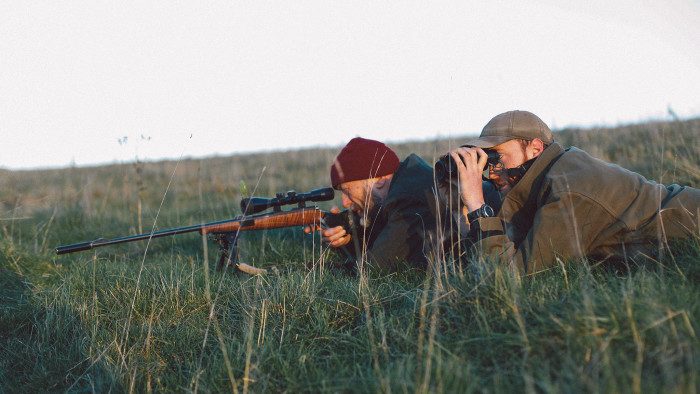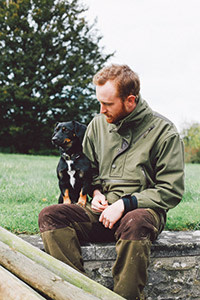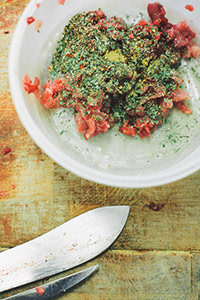Game shooting

Simply sign up to the Life & Arts myFT Digest -- delivered directly to your inbox.
I should make it clear at the outset that I’m nobody’s vegetarian. The moral arguments around killing and eating animals are complex but I’ve made a sort of peace with them. I believe humans have evolved as omnivores and can and should eat other creatures; I also believe that as a species we are civilised enough that we should reduce suffering wherever possible and, once we’ve killed an animal, respect it by cooking it well and eating it all, without waste.
Like many food lovers with this kind of approach to meat, I want to experience hunting the animal I eat yet I’m troubled by its social ramifications in the UK. Most shooting here is “driven”, where reared birds are startled by beaters into flight over or past a line of guns. It requires skill, it’s expensive, it has overtones of Downton-like privilege and I find this difficult. Many writers and chefs have taken the other route of deer stalking. This is more challenging than driven shooting, with long hikes and difficult manoeuvring into position for a shot but it’s more expensive and, arguably, even more elitist.
What I have been looking for is a model of shooting more like that practised in the rural US and the rest of Europe. No tweed, no beaters, just a walk with a gun to shoot something delicious for the pot. It sounds so simple but the combination of land ownership, gun and game laws in the UK means that such a connection with food is an opportunity open to very few – those with land or gamekeepers. The lore and skills of this kind of shooting – the marksmanship, the tracking, the fieldcraft, the understanding of weather, animal behaviour and field butchery – are traditionally passed down and, unless you are part of that small community, difficult to get involved in.
Chris Wheatley-Hubbard is one of the lucky ones. He grew up on a 2,500-acre estate in Wiltshire. He has had guns and animals about him all his life – apart from a stint as a graphic designer in London. Initially he learnt his craft from an older keeper and latterly trained as an APSI-certified (Association of Professional Shooting Instructors) advanced shooting instructor. Today Chris also runs bespoke courses for small groups and individuals, so I arranged to spend a couple of days with him at Boyton, the family seat. We discussed my requirements at some length: unlike a driven shoot there would be no guarantees of a kill. Instead I’d build up enough skills to go out and, if I was lucky enough to spot game, dispatch it well and responsibly.

I began by learning to walk. Chris showed me how to place my huge boots carefully so as to make minimum noise when moving through undergrowth and then led me on a half-hour silent walk along the edges of a field. It seemed odd at first, embarrassing for someone who had probably not spent 10 waking minutes in silence in 20 years, but within a short time I was adjusting to “the baseline”: the sights, sounds and smells of the environment. The art of tracking is less in being able to identify a species from its footprint and more in allowing the brain’s natural, deep-buried pattern-recognition software to alert you to subtle variations on the normal.
Next came a surprise. I’d expected a shotgun – the most common weapon for hunting in the UK, with a close effective range and a wide lethal spread. Instead, Chris took me to a range set up in a valley and produced a .22 rifle with a crosshair scope (telescopic sight). There are many things for which I owe thanks to my old-fashioned grammar school but I never imagined my Cadet Marksman badge would be one of them. I managed creditably, grouping five shots within 6cm at 75m range, pretty good for an out-of-practice urban hack, but then Chris turned my attention to a second target, a paper deer standing 25m further back. This time there was no convenient aiming point, just, as Chris described it, an imaginary vertical line behind the front leg, which I was to bisect halfway up the body.

I managed to get a cluster of shots in roughly the right place and we walked across the valley to examine the target. I was congratulating myself until Chris lifted the target sheet to reveal a diagram of the deer’s vital organs. As a cook, my understanding of animal physiology is pretty good but this was a great deal more immediate. “A little high. You’d have damaged the lungs and possibly the spine. You really need to clear the ribs here …and hit this area near the heart. That way the hydrostatic shock from the impact bursts blood vessels in the brain and the animal drops where it stands.” To my total relief it’s a clean kill but, he adds, “it could be better”.
Lunch is brief and conversation revolves around “terminal ballistics” – what happens when the bullet enters the animal, how it deforms, expands and damages internal organs. It’s not exactly what I’d choose to discuss over a pork pie but I’m beginning to realise that the process of preparing to pull the trigger is a lot more involved than a half hour on a range.
As the afternoon light mellows it’s time for the “deer run”. With Chris at my shoulder I have to walk silently a route through woods and field where there will be deer-shaped targets. I am to identify each imagined animal, establish that it’s safe to shoot, then, staying out of what would be its sightline, get myself and the rifle into a position to take a single shot. The first target glimpsed between trees appears to be a mother with her calf so I move on. The second is a suitable animal but, against a background of brush, I can’t be sure where my shot will go if it passes through or misses; another no go. Finally, through binoculars, I spot two deer close together, both suitable targets and one with a clear shot.

As Chris quietly instructs, I drop to my knees behind a rise and crawl what feels like 100m or so then drop flat on to my stomach for the final 50m, dragging myself forward on my elbows, pushing the rifle ahead of me. I am momentarily fazed as my chin narrowly avoids a crisp mound of sheep droppings but at Chris’s urging I push through. My breathing is now strained, my heart thundering and my brain racing as we crest the ridge to see the target straight ahead.
As I push the rifle into position and Chris slips in the magazine I realise that everything I managed to do on the range now feels almost impossible. I can’t get the scope into position to see through it; sweat is pouring into my eye. As I finally see light through the scope I can’t find the damn deer. I breathe deeper and try to calm my nerves. The shape comes into view more by luck than judgment and I begin the procedure of cocking the rifle, placing my finger correctly on the trigger and counting breaths. There’s a suppressed crack and the job is done.
We stand next to the target and examine the shot. Chris is pleased that it was clean, though a little high and left for perfection – a result of misjudged range and too sudden a pull at the trigger. I, on the other hand, am suddenly shaking.

The target, about the size of a large dog, has been accurately hit – I remembered most of what I’d been taught – but it felt like I’d taken a couple of minutes to sort myself out before pulling the trigger. A plywood shape is hard enough to hit but a real animal moves unpredictably and suddenly, and all the gory conversation over lunch comes into sobering perspective. Missing an animal would be humiliating and frustrating but an inaccurate hit would be catastrophic. The responsibility of making that single shot count has become very real. I talk to Chris about my worries.
“I’m really glad you’re getting it,” he says. “It’s a huge responsibility and there are lots of unpredictable factors. Everyone who hunts will take a bad shot at some point but you train so you minimise that chance. A good shooter who makes a bad shot will go straight back to the range and practise for hours before they consider going out again.”
As the sun begins to sink we set off in search of real game. I am secretly relieved at the absence of deer. I might have the philosophy squared away to my satisfaction but I’m not sure my technical skills are up to the job. The responsibility for taking a bad shot while under stress is beginning to weigh heavily then, quite suddenly, Chris spots rabbit at a distance I can barely perceive. You, like me, may have seen them in glorious abundance on motorway verges, oblivious to us, but this is not how they behave in their natural environment. Unused to cars and people and wary of predators from foxes to red kites, they occasionally pop up from their warrens but will bolt back underground at the sight or smell of a human.

The choice of the rifle suddenly makes sense – you’d never get close enough with a shotgun. For this reason I’m unprepared for a half-kilometre speed-hike, uphill and upwind of the two rabbits, the long and agonising crawl over wet, thistly, broken ground and a final slither downwards, amply lubricated by more sheep droppings, on to a ridge above the rabbits.
Again, it takes a while to settle myself and this time the targets are smaller and moving. Chris is at my shoulder, whispering quietly. “Left hand one. Wait till it turns sideways on. Brace the stock with your free hand.”
“I’ve lost it.”
“Breathe …and find it again. Wait …wait …”
As I squeeze the shot, I blink. The bullet makes an odd, drum-like sound but I can see nothing through the scope.
“Reload. Move right,” says Chris. “Take the second one.”
The second rabbit is clear in the sight now and I feel suddenly confident – too confident. The shot kicks up dust an inch behind its tail. The rabbit seems unperturbed.
“Reload …”
I reload and fire the four rounds remaining in the magazine, unerringly grouping them an inch behind the rabbit’s tail. Once again the incorrect positioning of my trigger finger is dragging the rifle far enough offline to make a difference. At this range and on a small target, it’s enough to spare the rabbit, which looks calmly around and disappears down its burrow before we can consider reloading.

As we scramble down the bank I’m surprised to find the first rabbit. A mercifully accurate shot. It’s lying entirely placid with eyes wide open. There’s a tiny entry wound exactly on the line and a slightly larger exit on the opposite side of its neck. “That noise [was] the shockwave as the bullet hits,” says Chris. “An instant kill.”
We gut and skin in the field, the messy yet oddly intimate process that somehow translates the rabbit from creature to meat. We head home and soon I’m back on more familiar territory, the butchery at the farm shop where we bone the rabbit and wrap the saddle around the chopped and seasoned leg meat to make a simple ballotine. It is literally a handful of meat and obtaining it from a live animal has been a two-day process – probably the most labour-intensive method imaginable. Yet, as I had hoped, every step has made me think more about what my decision to eat meat has meant. More particularly I realise that, as a society, we’ve made this rite of passage all but unattainable when, in a fairer world, it would be compulsory.
——————————————-
Tim Hayward is an FT Weekend contributing writer; Twitter: @TimHayward
Four Feathers Shooting School, Boyton Estate, Warminster, Wiltshire, BA12 0SS, www.ff-ruralcourses.co.uk; prices from £750 for a three-day residential weekender; prices for bespoke courses on request
Comments